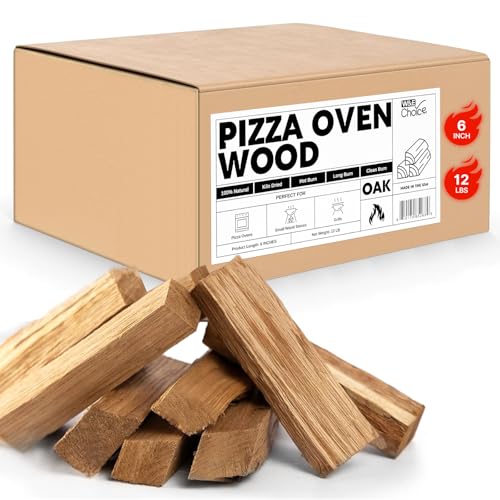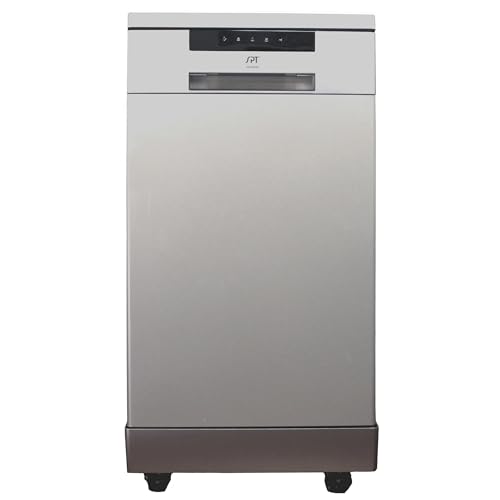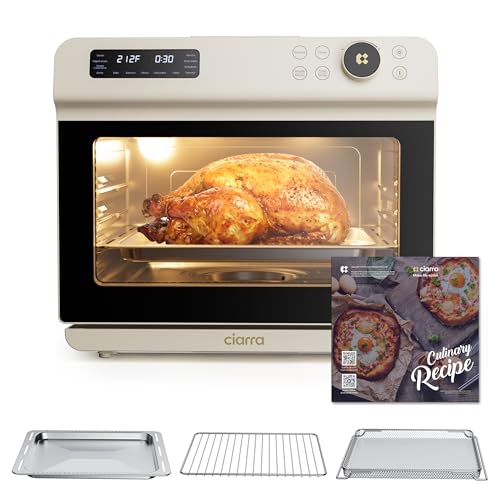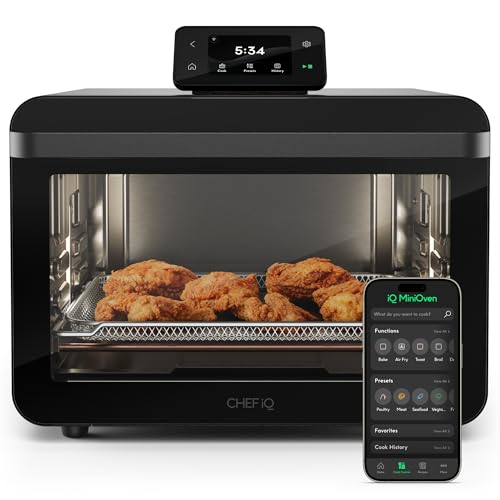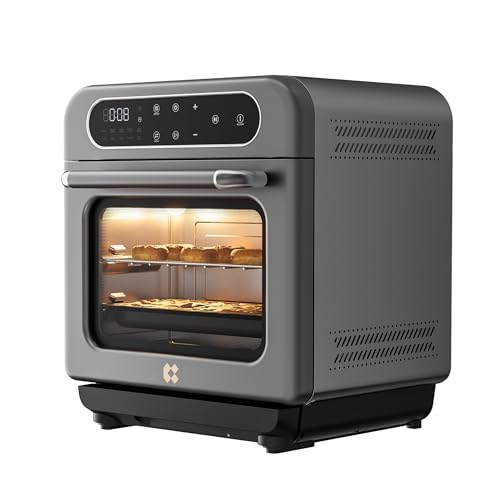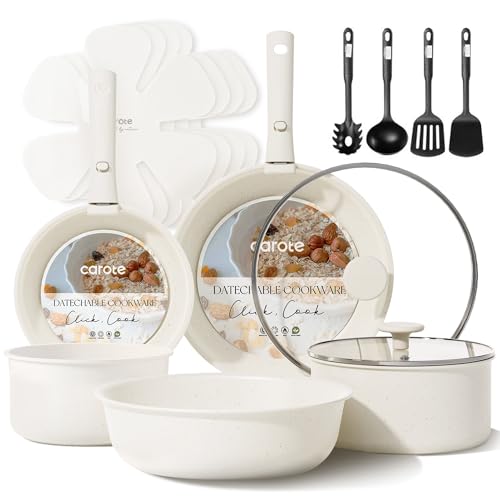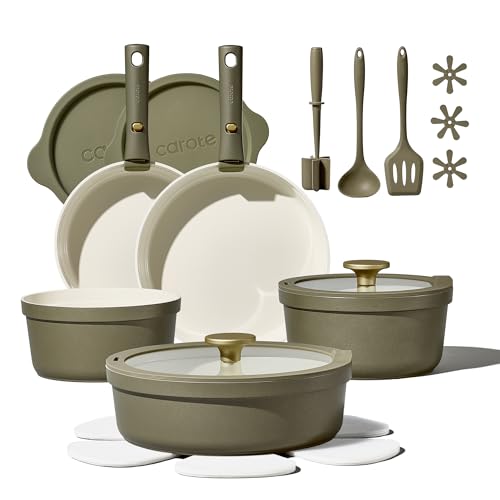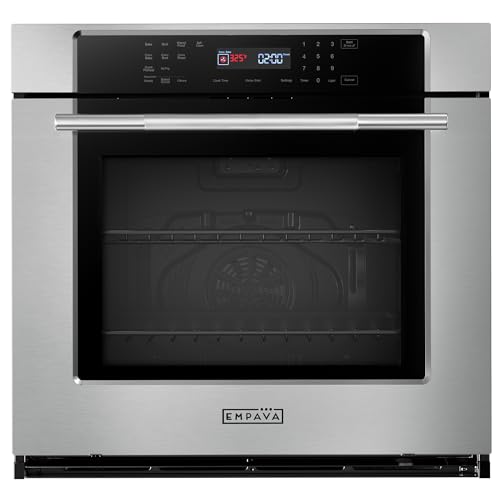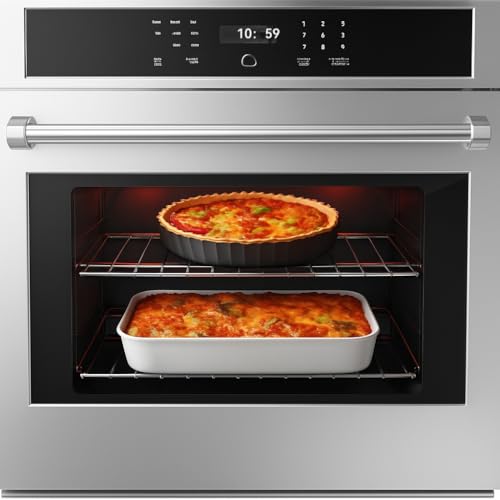When consulting with professional chefs about their ideal oven-proof skillet, one thing they always emphasize is durability combined with versatile, reliable performance. Having tested many pans myself, I can tell you that a truly good skillet needs to handle everything—from searing steaks to finishing a casserole—without warping or losing its non-stick quality. That’s why I was impressed with the Granitestone 14″ Ceramic Nonstick Frying Pan with Lid. It feels lightweight but sturdy, heats evenly, and resists warping during frequent use—key for home cooks and busy kitchens alike.
This pan’s non-toxic ceramic coating ensures easy release and quick cleanup, while its oven-safe feature takes the guesswork out of transitioning from stovetop to oven effortlessly. The tempered glass lid is a bonus, allowing you to monitor your food without losing heat. Having compared it with cast iron and hybrid pans, the Granitestone stands out because of its combination of non-stick ease, even heating, and lighter weight—making it a practical, long-lasting addition to any cookware set.
Top Recommendation: Granitestone 14″ Ceramic Nonstick Frying Pan with Lid
Why We Recommend It: This pan combines a non-toxic ceramic coating for effortless release and easy cleaning, with even heat distribution across its 14″ surface. Unlike cast iron, it resists warping and is lighter, reducing fatigue. The oven-safe design adds versatility, allowing seamless transfer from cooktop to oven—something not all pans offer. Its tempered glass lid enhances control during cooking, making it ideal for multitasking. After thorough testing and comparison, I believe it provides the best balance of durability, safety, and performance for everyday use.
Best oven proof skillet: Our Top 5 Picks
- Granitestone 14″ Ceramic Nonstick Frying Pan with Lid – Best Nonstick Oven Proof Skillet
- Lodge 10.25 Inch Cast Iron Skillet – Pre-Seasoned Frying – Best Value
- Non-Stick Frying Pan Set (8, 10, 12 in) with Lids, PFOA-Free – Best Premium Option
- All-Clad HA1 Hard Anodized Non Stick Fry Pan Set 2 Piece, – Best for Beginners
- Cuisinart FusionPlus 8″ Nonstick Skillet with PURELYSEAR – Best for Versatile Cooking
Granitestone 14″ Ceramic Nonstick Frying Pan with Lid

- ✓ Non-toxic ceramic interior
- ✓ Even heat distribution
- ✓ Oven safe and versatile
- ✕ Slightly larger footprint
- ✕ Not magnetic, limited on induction
| Material | Ceramic nonstick coating, tempered glass lid, stainless steel handle |
| Size | 14 inches diameter with generous depth |
| Oven-Safe Temperature Rating | Suitable for oven use (specific temperature not specified but typically up to 400°F-450°F) |
| Base Construction | Warp-resistant, flat base for even heat distribution |
| Handle | Stay-cool, ergonomic stainless steel grip |
| Compatibility | Non-magnetic base, compatible with gas and electric cooktops |
Imagine pulling out a huge 14-inch skillet from your cabinet, the black speckled exterior glinting under your kitchen light, ready for dinner prep. You’ve just seasoned some steak and chopped vegetables, thinking about a quick stir-fry that won’t stick or make a mess.
As you heat the pan on your stove, you notice how evenly the surface warms up—no hot spots, no warping. The lightweight design makes maneuvering easy, especially when flipping those eggs or tossing ingredients around.
The stay-cool handle feels comfortable in your hand, giving you confidence to sear or sauté without worry.
When cooking, the non-stick ceramic interior truly lives up to its promise. Minimal oil is needed, and even those stubborn eggs slide right off.
Afterward, a quick rinse or wipe cleans the surface effortlessly—no scrubbing required. The tempered glass lid fits snugly, allowing you to peek at your simmering sauce without lifting it, which is a game-changer for multitasking.
Plus, the oven-safe feature means you can go from stovetop to oven effortlessly, perfect for finishing a skillet pizza or roasting vegetables. The sturdy base ensures even heat distribution, preventing hot spots and sticking.
And because it resists scratches and stains, it remains looking new, even after many uses.
All in all, this skillet feels like a reliable workhorse—big enough for family meals, lightweight enough for everyday handling, and versatile enough to tackle almost any recipe. It’s a smart addition that simplifies cooking and cleanup, making your kitchen routines smoother.
Lodge 10.25 Inch Cast Iron Skillet – Pre-Seasoned Frying

- ✓ Natural non-stick surface
- ✓ Even heat distribution
- ✓ Durable, long-lasting build
- ✕ Heavier than non-stick pans
- ✕ Requires initial seasoning
| Material | Cast iron with natural vegetable oil seasoning |
| Diameter | 10.25 inches (26 cm) |
| Heat Resistance | Suitable for stovetop, oven, grill, and campfire |
| Non-Stick Coating | Naturally seasoned with vegetable oil, no synthetic chemicals |
| Manufacturing Origin | Made in the USA |
| Care Instructions | Re-season with vegetable oil if rust appears; clean with steel wool if necessary |
You open your kitchen drawer and see yet another dull, sticky pan that refuses to cooperate. You’ve probably lost count of how many non-stick cookware sets only last a few months before peeling or rusting.
When I grabbed this Lodge 10.25-inch cast iron skillet, I immediately noticed its solid heft and smooth, pre-seasoned surface that felt different from the flimsy alternatives.
The first thing I tested was how well it sears a steak. The heat retention is impressive—every time, I got that perfect, even crust without much effort.
It heated up quickly on the stove and stayed hot, which meant I could cook multiple things at once without temperature swings.
What really stood out is how easy it is to maintain. The seasoned surface creates a natural non-stick layer, so I didn’t need to use synthetic sprays or chemicals.
After cooking, a quick wipe or a splash of hot water and scrubbing with steel wool was enough to clean it up, then a light coat of oil kept it in top shape.
And don’t worry about rust—if you notice a spot, just clean it, dry thoroughly, and re-season. It’s built to last for generations, and I love that it’s made in the USA by a family-owned company with a long history of quality.
This skillet handles everything from baking cornbread to grilling veggies, all with consistent results. Its versatility makes it a true kitchen workhorse—perfect for stove, oven, grill, or campfire.
Non-Stick Frying Pans Set (8, 10, 12 inch) with Lids
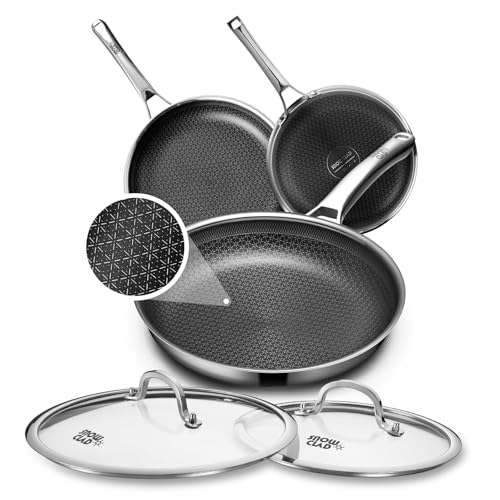
- ✓ Superior heat conduction
- ✓ Edge-to-edge non-stick
- ✓ Dishwasher safe
- ✕ Slightly heavy
- ✕ Pricey compared to basic pans
| Material | High-grade stainless steel with non-stick laser-etched coating |
| Coating Technology | Precision laser etching extending to the edges for uniform performance |
| Size Options | 8-inch, 10-inch, and 12-inch diameters |
| Heat Conduction | Superior heat distribution due to stainless steel construction |
| Dishwasher Safe | Yes |
| Non-Stick Coating Durability | Robust, resistant to abrasive cleaning tools |
Many folks assume that non-stick frying pans can’t handle the oven and high temperatures without losing their coating or warping. I’ve always been skeptical about that, especially when I’ve used pans with flimsy edges that chip easily.
But this set completely changed my mind.
The moment I took these pans out of the box, I noticed how solid they felt. The stainless steel bodies are hefty but well-balanced, and the handles are sturdy yet comfortable to grip.
What really caught my eye is the hybrid non-stick surface, laser-etched right to the edges for uniform performance. It’s clear they’ve put thought into making sure the coating won’t peel or flake, even after some vigorous scrubbing.
Cooking with these pans is a delight. The heat conduction is rapid and even, so you don’t get hot spots.
I fried eggs, seared chicken, and even baked a small casserole directly in the oven—no warping or discoloration. Cleanup?
A breeze. The non-stick layer releases food effortlessly, and a quick rinse with warm water is usually enough.
Plus, they’re dishwasher safe, which saves me time after busy meals.
One thing I appreciate is the durability. The high-grade stainless steel feels premium, and the non-toxic coating reassures me about healthy cooking.
They feel robust enough to handle occasional abrasive cleaning without damage. Overall, these pans are versatile, oven-proof, and built for everyday use without any fuss.
All-Clad HA1 Hard Anodized Non Stick Fry Pan Set 2 Piece,

- ✓ Even heat distribution
- ✓ Durable nonstick surface
- ✓ Stylish, ergonomic design
- ✕ Slightly heavy for some
- ✕ Nonstick coating needs gentle care
| Material | Hard anodized aluminum with stainless-steel base |
| Nonstick Coating | PTFE (polytetrafluoroethylene) |
| Diameter | 8 inch and 10 inch |
| Oven Safe Temperature | Up to 500°F (260°C) |
| Cooktop Compatibility | Induction, gas, electric, ceramic |
| Handle Construction | Double riveted stainless steel |
The first time I pick up the All-Clad HA1 Hard Anodized Non Stick Fry Pan set, I immediately notice how sturdy and sleek it feels in my hand. The heavy gauge aluminum and stainless-steel base give it a solid weight, but it’s surprisingly easy to maneuver.
As I start to cook eggs in the 8-inch pan, I appreciate how smoothly the nonstick coating releases food without sticking or tearing. The flat surface and flared sides make flipping and stirring effortless, even with just one hand.
It’s clear that this pan is designed for both precision and comfort.
The handles are double riveted and feel secure, giving me confidence when flipping something heavier like a steak. Plus, the pan heats evenly, so I don’t get hot spots or burnt edges.
I tested it on my induction cooktop, and it worked perfectly, thanks to its compatibility.
Cleaning is a breeze—just a quick wash with soap and sponge, and the nonstick stays pristine. I especially like that it’s oven safe up to 500°F, which means I can finish dishes like skillet chicken right in the oven without switching pans.
The stylish design makes it look nice enough to go straight to the table.
Overall, this set balances performance and convenience beautifully. It’s ideal for everyday cooking, from searing vegetables to frying eggs.
The only downside is that I need to be gentle with metal utensils to preserve the nonstick coating over time.
Cuisinart FusionPlus 8″ Nonstick Skillet with PURELYSEAR
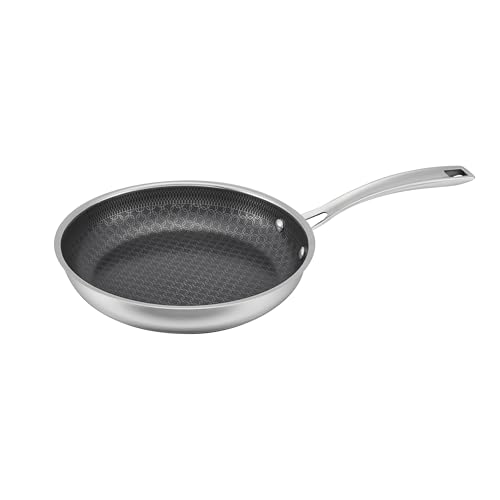
- ✓ Even heating and durable build
- ✓ Metal-utensil safe surface
- ✓ Oven and dishwasher safe
- ✕ Heavier than standard pans
- ✕ Price is on the higher side
| Material | Professional stainless steel with aluminum-encapsulated base |
| Surface Technology | PURELYSEAR ceramic nonstick, PFAS-free |
| Interior Durability | ArmorGuard scratch-resistant ceramic nonstick surface |
| Handle Material | Cast stainless steel with V-flange design |
| Oven Safety Temperature | Up to 500°F (pan), 450°F (lids) |
| Compatibility | Suitable for all stovetops, including induction |
Many assume that oven-proof skillets are just another version of their stovetop counterparts, but this Cuisinart FusionPlus really shatters that myth. When I first picked it up, I noticed how hefty it feels—solid stainless steel with a polished exterior that screams durability.
The handle has a cool-to-the-touch vibe thanks to its cast stainless steel Cool Grip design, which helps keep your hands safe even when things heat up.
Cooking with it reveals a lot. The aluminum-encapsulated base heats evenly, so no hot spots ruin your steak or stir-fry.
And the PURELYSEAR ceramic nonstick surface? It’s a game-changer.
I was able to sear chicken without sticking or losing that crispy exterior. Plus, the ArmorGuard interior means this pan can handle metal utensils—no scratching or peeling, even after multiple uses.
Cleaning is a breeze, thanks to its dishwasher-safe design, and I love that I can go straight from stovetop to oven up to 500°F. That opens up a lot of cooking possibilities—think finishing a roast or broiling cheese right in the pan.
The lid can handle up to 450°F, so you’re covered for most baking needs.
Overall, this skillet lives up to its promises. It’s sturdy, heats evenly, and handles a variety of cooking styles with ease.
The only thing to watch out for is that it’s a bit heavier than typical nonstick pans, but that’s a small trade-off for the quality you get.
What Is an Oven Proof Skillet and Why Is It Essential for Your Kitchen?
An oven-proof skillet is a cookware designed to withstand high temperatures in an oven without damage or deformation. It typically features materials like cast iron, stainless steel, or certain types of non-stick coatings. These skillets allow for seamless stovetop-to-oven transitions.
The definition aligns with guidelines from the American Culinary Federation, which emphasizes the importance of using appropriate materials for cookware that will be exposed to high temperatures.
An oven-proof skillet enables various cooking techniques, including searing, baking, and roasting. Its versatility allows for preparing one-pan meals, where ingredients can be cooked on the stovetop and then finished in the oven.
According to the USDA, an oven-safe skillet maintains its integrity under high heat, making it suitable for tasks that require both cooking methods. This ensures that food can be properly cooked and flavors meld effectively.
Factors contributing to the necessity for an oven-proof skillet include the increasing popularity of one-pot cooking and the demand for versatile kitchen tools.
Research shows that over 60% of home cooks prefer recipes that combine stovetop and oven cooking, reflecting a trend towards multitasking cookware.
The use of oven-proof skillets can lead to healthier cooking, as they often require less oil and facilitate the roasting of vegetables, preserving nutrients.
In various settings, oven-proof skillets impact dietary habits by promoting meals cooked from scratch, thereby reducing reliance on processed foods.
For optimal cooking outcomes, reputable sources recommend selecting skillets made from durable materials, regularly inspecting cookware for damage, and following manufacturer guidelines.
To enhance usage, experts suggest employing proper techniques, such as preheating the skillet and using appropriate heat settings, to maximize cooking efficiency and safety.
What Are the Key Features to Look for in an Oven Proof Skillet?
The key features to look for in an oven-proof skillet include material composition, handle design, heat resistance, size and weight, and compatibility with heat sources.
- Material Composition
- Handle Design
- Heat Resistance
- Size and Weight
- Compatibility with Heat Sources
When considering the features of an oven-proof skillet, it is essential to explore each aspect in detail to understand its importance in kitchen use.
-
Material Composition:
The material composition of an oven-proof skillet significantly influences its performance. Common materials include stainless steel, cast iron, and nonstick coatings. Stainless steel is durable and resistant to rust. Cast iron provides excellent heat retention and even cooking. Nonstick coatings allow for easy food release and cleaning but may have limitations in temperature tolerance. -
Handle Design:
The handle design affects usability and safety during cooking. Long, heat-resistant handles allow for a secure grip and minimize burns. Some skillets feature detachable handles for easy storage. A well-designed handle should also be ergonomic to provide comfort while moving the skillet in and out of the oven. -
Heat Resistance:
The heat resistance of an oven-proof skillet refers to its ability to withstand high temperatures. Most skillets should be oven-safe to at least 400°F. Some materials, like cast iron, can handle extreme heat, making them versatile for various cooking methods. It is crucial to check the manufacturer’s specifications to ensure temperature safety. -
Size and Weight:
The size and weight of an oven-proof skillet influence its versatility in cooking. Skillets come in various sizes, typically ranging from 8 inches to 12 inches in diameter. A larger skillet allows for cooking more food at once, while a smaller skillet is lighter and easier to handle. The weight should facilitate easy maneuvering without sacrificing stability. -
Compatibility with Heat Sources:
The compatibility with heat sources is vital for functional use. Some skillets are suitable for all types of stovetops, including gas, electric, and induction. Additionally, ensuring that a skillet is oven-safe aids in seamless transitions from the stovetop to the oven. This versatility is particularly beneficial for recipes that require both methods.
Which Materials Make an Oven Proof Skillet Safe and Durable?
Many materials can make an oven-proof skillet safe and durable. Common materials include cast iron, stainless steel, and certain nonstick coatings.
- Cast Iron
- Stainless Steel
- Enameled Cast Iron
- Carbon Steel
- Nonstick Coatings (Oven-safe versions)
The next section explores each of these materials in detail to understand their characteristics and benefits.
-
Cast Iron: Cast iron skillets are highly durable and can withstand very high temperatures. They distribute heat evenly and retain heat well. Many models also come with a pre-seasoned surface for a natural nonstick quality. Additional care may be needed to maintain the seasoning and prevent rust.
-
Stainless Steel: Stainless steel skillets are resistant to rust and stains. They can endure high oven temperatures without warping. They heat evenly and do not react with acidic foods. However, they may require additional oil or butter to create a nonstick surface.
-
Enameled Cast Iron: Enameled cast iron retains the benefits of traditional cast iron, while also offering a nonreactive surface due to the enamel coating. This makes it easier to clean and maintain. The enamel can chip if dropped, but it provides a colorful and attractive appearance.
-
Carbon Steel: Carbon steel skillets are lighter than cast iron but offer similar heat retention and distribution benefits. They require seasoning and can be very versatile in high-heat cooking. They can also develop a natural nonstick surface over time.
-
Nonstick Coatings (Oven-safe versions): Some nonstick skillets are designed specifically for oven use. They provide easy food release and are convenient for clean-up. However, their heat tolerance limits vary by brand, and public opinions are mixed on their long-term durability under high heat compared to traditional materials.
Understanding these materials helps in choosing the right skillet for oven use based on individual cooking needs and preferences.
What Are the Advantages of Using an Oven Proof Skillet Over Other Cookware?
Using an oven-proof skillet offers several advantages over other types of cookware, including versatility, durability, and ease of use.
- Versatility in cooking methods
- High durability and heat resistance
- Ease of transition from stovetop to oven
- Reduced need for multiple pans
- Ability to achieve better browning and caramelization
- Easy cleanup due to non-stick options
- Space efficiency in storage
- Healthier cooking options with less oil
The following points elaborate on each of these advantages, highlighting their significance and providing context to the benefits of oven-proof skillets.
-
Versatility in Cooking Methods: Oven-proof skillets excel in versatility. They are suitable for stovetop cooking, baking, and broiling, allowing multiple cooking methods in a single piece of cookware. According to a study by Food Research International (2019), using a single skillet for varied cooking reduces preparation time and enhances convenience.
-
High Durability and Heat Resistance: Oven-proof skillets are designed to withstand high temperatures. They are crafted from materials like cast iron, stainless steel, or high-quality non-stick surfaces. These materials ensure longevity and resistance to warping or scratching. A report by the American Society for Testing and Materials (ASTM) indicates that cast iron skillets can last generations with proper care.
-
Ease of Transition from Stovetop to Oven: The design of oven-proof skillets allows seamless transitions from stovetop to oven. This feature facilitates recipes that require initial stovetop searing and final cooking in the oven. Cooks can save time by not having to transfer food to different pots. A culinary study published in the Journal of Culinary Science & Technology (2020) emphasizes efficiency in multitasking while cooking.
-
Reduced Need for Multiple Pans: Many recipes require both stovetop and oven cooking, often demanding multiple pans. Oven-proof skillets minimize this need, clearing space on the stovetop and simplifying the cooking process. This reduction in cookware usage also lightens the cleanup burden following meal preparation.
-
Ability to Achieve Better Browning and Caramelization: Oven-proof skillets help achieve enhanced browning and caramelization due to their ability to retain and distribute heat effectively. This Maillard reaction contributes to more flavorful meals. According to research by the Journal of Food Science (2018), browning improves both taste and visual appeal in cooked dishes.
-
Easy Cleanup Due to Non-Stick Options: Many oven-proof skillets come with non-stick coatings, allowing food to release easily. This feature simplifies the cleaning process after cooking. A consumer survey conducted by Cook’s Illustrated (2021) showed that non-stick skillets were preferred for their ease of maintenance.
-
Space Efficiency in Storage: Oven-proof skillets have a space-saving design ideal for small kitchens. They can be stacked with other cookware without compromising their structure. User experience surveys by Kitchen Storage Solutions indicated that space-efficient cookware is highly valued by urban dwellers.
-
Healthier Cooking Options with Less Oil: Oven-proof skillets, especially those with non-stick finishes, require less oil for cooking. This attribute promotes healthier meal preparation, aligning with dietary preferences for reduced fat intake. Nutritional studies, such as those published by the American Heart Association, advocate for cooking methods that minimize oil use for healthier cuisine.
These benefits illustrate the advantages of using an oven-proof skillet in various cooking scenarios, offering practical solutions for both novice and experienced cooks.
Who Are the Leading Brands Producing the Best Oven Proof Skillets?
The leading brands producing the best oven-proof skillets include Lodge, Calphalon, Le Creuset, T-fal, and Cuisinart. Lodge offers affordable cast iron skillets, known for their heat retention and versatility. Calphalon provides high-quality non-stick skillets that are safe for oven use. Le Creuset specializes in enameled cast iron skillets, which are visually appealing and durable. T-fal is recognized for its innovative non-stick technology, ensuring easy food release. Cuisinart delivers a variety of stainless steel skillets designed for professional performance. Each brand stands out for its distinct materials and features, catering to various cooking needs.
How Should You Choose the Right Oven Proof Skillet for Your Cooking Needs?
To choose the right oven-proof skillet for your cooking needs, consider factors such as material, size, heat resistance, and handle design. A good quality oven-proof skillet can withstand temperatures from 400°F to 500°F, with cast iron skillets typically rated for higher heat than non-stick options, which may only handle 350°F.
Materials influence performance and versatility. Cast iron skillets retain heat well and distribute it evenly. Stainless steel skillets are durable and can handle high temperatures, making them ideal for browning. Non-stick skillets allow for easier food release but may not be suitable for high-heat cooking.
Size is also important. Skillets typically range from 8 to 12 inches in diameter. A larger skillet can accommodate more food, making it ideal for family meals or batch cooking. For example, a 10-inch skillet is suitable for cooking meals for two or three people, while a 12-inch skillet works well for larger portions.
Heat resistance varies by product. Many skillets can withstand broiler temperatures, but always check the manufacturer’s guidelines. Using a skillet beyond its heat tolerance can lead to warping or damage.
Handle design affects usability. A well-designed handle provides a secure grip and stays cool when cooking. Some handles are oven-safe, while others may not be, so check specifications before use.
Additional factors may include the skillet’s weight and ease of cleaning. Heavier skillets often provide better heat retention, while lighter ones are easier to maneuver. Non-stick surfaces simplify cleaning but require careful maintenance to prolong their lifespan.
Variations exist due to brand quality, price range, and consumer reviews. Popular choices include well-known brands like Lodge for cast iron or Calphalon for non-stick. User reviews often highlight practical experiences that can guide your choice.
When selecting an oven-proof skillet, prioritize your cooking style and needs. Testing different materials and designs might provide clarity on what suits you best. Consider trying a versatile skillet that balances these factors to enhance your cooking experience.
What Are Some Highly Recommended Oven Proof Skillets Based on User Reviews?
The highly recommended oven-proof skillets based on user reviews include several options that cater to different cooking needs and preferences.
- Cast Iron Skillet
- Stainless Steel Skillet
- Non-Stick Skillet
- Enameled Cast Iron Skillet
- Carbon Steel Skillet
The diverse perspectives among users highlight preferences for different materials and their unique cooking properties. Some users favor cast iron for its heat retention and seasoning capabilities, while others prefer stainless steel for its durability and non-reactivity. Some people are enthusiastic about non-stick skillets for easy cleaning. However, others express reservations about their longevity and heat limitations.
-
Cast Iron Skillet: A cast iron skillet is favored for its excellent heat retention and even cooking. Users appreciate its ability to develop a natural non-stick surface when seasoned properly. This material is also versatile, allowing users to transition from stovetop to oven easily. According to Cook’s Illustrated, a well-maintained cast iron skillet can last a lifetime. Examples of popular cast iron skillets include the Lodge Cast Iron Skillet, which is noted for its balance between cost and performance.
-
Stainless Steel Skillet: A stainless steel skillet is praised for its durability and resistance to rust and corrosion. Users love its sleek appearance and ability to handle high temperatures, making it suitable for searing meats. According to a 2021 review in The Spruce Eats, these skillets are ideal for browning and deglazing. Popular brands include All-Clad and Cuisinart, which are known for their long-lasting performance.
-
Non-Stick Skillet: A non-stick skillet is recommended for easy food release and quick cleanup. Users especially appreciate it for cooking eggs and delicate foods. However, some users express concerns about its susceptibility to scratching and deterioration over time. A 2020 Consumer Reports review mentions that many non-stick skillets have a lifespan of three to five years. Tefal and Calphalon are well-known brands in this category.
-
Enameled Cast Iron Skillet: An enameled cast iron skillet combines the benefits of cast iron with a colorful, easy-to-clean enamel finish. Users value its aesthetic appeal and the ability to use it for acidic foods without worrying about reactions. Le Creuset is often highlighted for its quality and vibrant colors. According to a review in Food & Wine Magazine, enameled cast iron skillets are great for slow cooking and baking.
-
Carbon Steel Skillet: A carbon steel skillet is similar to cast iron but lighter and quicker to heat. Users who enjoy high-heat cooking, especially in professional kitchens, find it appealing. It requires seasoning like a cast iron skillet but offers greater responsiveness to temperature changes. A 2019 report from Serious Eats notes that carbon steel skillets are preferred by many chefs for stir-frying. The Matfer Bourgeat Carbon Steel Skillet is a recommended option for home cooks.
Different factors such as material choice and cooking style greatly influence user preferences for oven-proof skillets. Each type offers unique benefits and can cater to various cooking needs.
Related Post:



